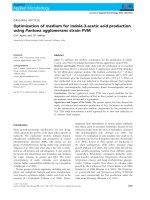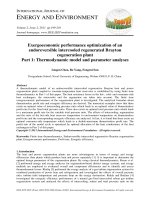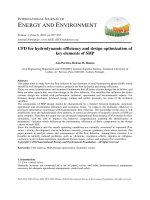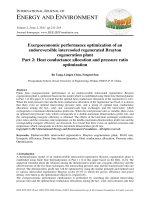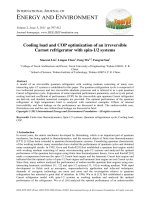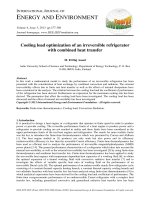optimization of chemical processes
Bạn đang xem bản rút gọn của tài liệu. Xem và tải ngay bản đầy đủ của tài liệu tại đây (17.99 MB, 887 trang )
v
Preface xi
About the Authors xiv
PART I Problem Formulation
1 The Nature and Organization of Optimization Problems 3
1.1 What Optimization Is All About 4
1.2 Why Optimize? 4
1.3 Scope and Hierarchy of Optimization 5
1.4 Examples of Applications of Optimization 8
1.5 The Essential Features of Optimization Problems 14
1.6 General Procedure for Solving Optimization Problems 18
1.7 Obstacles to Optimization 26
References 27
Supplementary References 27
Problems 28
2 Developing Models for Optimization 37
2.1 Classification of Models 41
2.2 How to Build a Model 46
2.3 Selecting Functions to Fit Empirical Data 48
2.3.1 How to Determine the Form of a Model / 2.3.2 Fitting
Models by Least Squares
2.4 Factorial Experimental Designs 62
2.5 Degrees of Freedom 66
2.6 Examples of Inequality and Equality Constraints in Models 69
References 73
Supplementary References 73
Problems 74
CONTENTS
edg93591_fm.qxd 12/8/00 9:59 AM Page v
3 Formulation of the Objective Function 83
3.1 Economic Objective Functions 84
3.2 The Time Value of Money in Objective Functions 91
3.3 Measures of Profitability 100
References 104
Supplementary References 104
Problems 105
Part II Optimization Theory and Methods
4 Basic Concepts of Optimization 113
4.1 Continuity of Functions 114
4.2 NLP Problem Statement 118
4.3 Convexity and Its Applications 121
4.4 Interpretation of the Objective Function in Terms of its Quadratic
Approximation 131
4.5 Necessary and Sufficient Conditions for an Extremum
of an Unconstrained Function 135
References 142
Supplementary References 142
Problems 142
5 Optimization of Unconstrained Functions: One-Dimensional
Search
152
5.1 Numerical Methods for Optimizing a Function of One Variable 155
5.2 Scanning and Bracketing Procedures 156
5.3 Newton and Quasi-Newton Methods of Unidimensional Search 157
5.3.1 Newton’s Method / 5.3.2 Finite Difference Approximations to
Derivatives / 5.3.3 Quasi-Newton Method
5.4 Polynomial Approximation Methods 166
5.4.1 Quadratic Interpolation / 5.4.2 Cubic Interpolation
5.5 How One-Dimensional Search Is Applied in a
Multidimensional Problem 173
5.6 Evaluation of Unidimensional Search Methods 176
References 176
Supplementary References 177
Problems 177
6 Unconstrained Multivariable Optimization 181
6.1 Methods Using Function Values Only 183
6.1.1 Random Search / 6.1.2 Grid Search / 6.1.3 Univariate
Search / 6.1.4 Simplex Search Method / 6.1.5 Conjugate Search
Directions / 6.1.6 Summary
6.2 Methods That Use First Derivatives 189
6.2.1 Steepest Descent / 6.2.2 Conjugate Gradient Methods
vi Contents
edg93591_fm.qxd 12/8/00 9:59 AM Page vi
6.3 Newton’s Method 197
6.3.1 Forcing the Hessian Matrix to Be Positive-Definite /
6.3.2 Movement in the Search Direction / 6.3.3 Termination /
6.3.4 Safeguarded Newton’s Method / 6.3.5 Computation of
Derivatives
6.4 Quasi-Newton Methods 208
References 210
Supplementary References 211
Problems 211
7 Linear Programming (LP) and Applications 222
7.1 Geometry of Linear Programs 223
7.2 Basic Linear Programming Definitions and Results 227
7.3 Simplex Algorithm 233
7.4 Barrier Methods 242
7.5 Sensitivity Analysis 242
7.6 Linear Mixed Integer Programs 243
7.7 LP Software 243
7.8 A Transportation Problem Using the EXCEL Solver
Spreadsheet Formulation 245
7.9 Network Flow and Assignment Problems 252
References 253
Supplementary References 253
Problems 254
8 Nonlinear Programming with Constraints 264
8.1 Direct Substitution 265
8.2 First-Order Necessary Conditions for a Local Extremum 267
8.2.1 Problems Containing Only Equality Constraints /
8.2.2 Problems Containing Only Inequality Constraints /
8.2.3 Problems Containing both Equality and Inequality
Constraints
8.3 Quadratic Programming 284
8.4 Penalty, Barrier, and Augmented Lagrangian Methods 285
8.5 Successive Linear Programming 293
8.5.1 Penalty Successive Linear Programming
8.6 Successive Quadratic Programming 302
8.7 The Generalized Reduced Gradient Method 306
8.8 Relative Advantages and Disadvantages of NLP Methods 318
8.9 Available NLP Software 319
8.9.1 Optimizers for Stand-Alone Operation or Embedded
Applications / 8.9.2 Spreadsheet Optimizers / 8.9.3 Algebraic
Modeling Systems
8.10 Using NLP Software 323
8.10.1 Evaluation of Derivatives: Issues and Problems /
8.10.2 What to Do When an NLP Algorithm Is Not “Working”
Contents vii
edg93591_fm.qxd 12/8/00 9:59 AM Page vii
References 328
Supplementary References 329
Problems 329
9 Mixed-Integer Programming 351
9.1 Problem Formulation 352
9.2 Branch-and-Bound Methods Using LP Relaxations 354
9.3 Solving MINLP Problems Using Branch-and-Bound Methods 361
9.4 Solving MINLPs Using Outer Approximation 369
9.5 Other Decomposition Approaches for MINLP 370
9.6 Disjunctive Programming 371
References 372
Supplementary References 373
Problems 374
10 Global Optimization for Problems with Continuous and
Discrete Variables
381
10.1 Methods for Global Optimization 382
10.2 Smoothing Optimization Problems 384
10.3 Branch-and-Bound Methods 385
10.4 Multistart Methods 388
10.5 Heuristic Search Methods 389
10.5.1 Heuristic Search / 10.5.2 Tabu Search / 10.5.3 Simulated
Annealing / 10.5.4 Genetic and Evolutionary Algorithms /
10.5.5 Using the Evolutionary Algorithm in the Premium
Excel Solver / 10.5.6 Scatter Search
10.6 Other Software for Global Optimization 411
References 412
Supplementary References 413
Part III Applications of Optimization
11 Heat Transfer and Energy Conservation 417
Example 11.1 Optimizing Recovery of Waste Heat 419
Example 11.2 Optimal Shell-and-Tube Heat Exchanger Design 422
Example 11.3 Optimization of a Multi-Effect Evaporator 430
Example 11.4 Boiler/Turbo-Generator System Optimization 435
References 438
Supplementary References 439
12 Separation Processes 441
Example 12.1 Optimal Design and Operation of a Conventional
Staged-Distillation Column 443
viii Contents
edg93591_fm.qxd 12/8/00 9:59 AM Page viii
Example 12.2 Optimization of Flow Rates in a Liquid–Liquid
Extraction Column 448
Example 12.3 Fitting Vapor–Liquid Equilibrium Data Via
Nonlinear Regression 451
Example 12.4 Determination of the Optimal Reflux Ratio for a
Staged-Distillation Column 453
References 458
Supplementary References 458
13 Fluid Flow Systems 460
Example 13.1 Optimal Pipe Diameter 461
Example 13.2 Minimum Work of Compression 464
Example 13.3 Economic Operation of a Fixed-Bed Filter 466
Example 13.4 Optimal Design of a Gas Transmission Network 469
References 478
Supplementary References 478
14 Chemical Reactor Design and Operation 480
Example 14.1 Optimization of a Thermal Cracker Via Linear Programming 484
Example 14.2 Optimal Design of an Ammonia Reactor 488
Example 14.3 Solution of an Alkylation Process by Sequential Quadratic
Programming 492
Example 14.4 Predicting Protein Folding 495
Example 14.5 Optimization of Low-Pressure Chemical Vapor Deposition
Reactor for the Deposition of Thin Films 500
Example 14.6 Reaction Synthesis Via MINLP 508
References 513
Supplementary References 514
15 Optimization in Large-Scale Plant Design and Operations 515
15.1 Process Simulators and Optimization Codes 518
15.2 Optimization Using Equation-Based Process Simulators 525
15.3 Optimization Using Modular-Based Simulators 537
15.3.1 Sequential Modular Methods / 15.3.2 Simultaneous
Modular Methods / 15.3.3 Calculation of Derivatives
15.4 Summary 546
References 546
Supplementary References 548
16 Integrated Planning, Scheduling, and Control in the Process
Industries
549
16.1 Plant Optimization Hierarchy 550
16.2 Planning and Scheduling 553
16.2.1 Planning / 16.2.2 Scheduling
Contents ix
edg93591_fm.qxd 12/8/00 9:59 AM Page ix
16.3 Plantwide Management and Optimization 565
16.4 Unit Management and Control 567
16.4.1 Formulating the MPC Optimization Problem
16.5 Process Monitoring and Analysis 575
References 579
Supplementary References 581
Appendixes 583
A Mathematical Summary 583
A.1 Definitions / A.2 Basic Matrix Operations / A.3 Linear
Independence and Row Operations / A.4 Solution of Linear
Equations / A.5 Eigenvalues, Eigenvectors / References /
Supplementary References / Problems
B Cost Estimation 603
B.1 Capital Costs / B.2 Operating Costs / B.3 Taking Account of
Inflation / B.4 Predicting Revenues in an Economic-Based
Objective Function / B.5 Project Evaluation / References
Nomenclature 631
Name Index 637
Subject Index 643
x Contents
edg93591_fm.qxd 12/8/00 9:59 AM Page x
OPTIMIZATION OF CHEMICAL PROCESSES
McGraw-Hill Chemical Engineering Series
EDITORIAL ADVISORY BOARD
Eduardo
D.
Glandt, Professor of Chemical Engineering, University of
Pennsylvania
Michael
T.
Klein, Professor of Chemical Engineering, Rutgers University
Thomas
E
Edgar, Professor of Chemical Engineering, University of Texas at
Austin
Bailey and Ollis:
Biochemical Engineering Fundamentals
Bennett and Myers:
Momentum, Heat, and Mass Transfer
Coughanowr:
Process Systems Analysis and Control
deNevers:
Air Pollution Control Engineering
deNevers:
Fluid Mechanics for Chemical Engineers
Douglas:
Conceptual Design of Chemical Processes
Edgar, Himmelblau, and Lasdon:
Optimization of Chemical Processes
Gates, Katzer, and Schuit:
Chemistry of Catalytic Processes
King:
Separation Processes
Luyben:
Essentials of Process Control
Luyben:
Process Modeling, Simulation, and Control for Chemical Engineers
Marlin:
Process Control: Designing Processes and Control Systems for Dynamic
Pe$ormance
McCabe, Smith4nd Harriott:
Unit Operations of Chemical Engineering
Middleman and Hochberg:
Process Engineering Analysis in Semiconductor Device
Fabrication
.
1,
Perry and Green:
Perry's Chemical Engineers' Handbook
Peters and Timmerhaus:
Plant Design and ~conomics fof chemical Engineers
Reid, Prausnitz, and Poling:
Properties of Gises and Liquids
Smith, Van Ness, and Abbott:
Introduction tg~&micbl Engineering Thermodynamics
Treybal:
Mass Transfer Operations
-
.
',
McGraw-Hill Higher Education
A
Bvision
of
The
McGraw-His
Companies
OPTIMIZATION OF CHEMICAL PROCESSES, SECOND EDITION
Published by McGraw-Hill, a business unit of The McGraw-Hill Companies, Inc., 1221 Avenue of the
Americas, New York, NY 10020. Copyright
O
2001, 1988 by The McGraw-Hill Companies, Inc. All
rights reserved. No part of this publication may be reproduced or distributed in any form or by any
means, or stored in a database or retrieval system, without the prior written consent of The
McGraw-
Hill Companies, Inc., including, but not limited to, in any network or other electronic storage or trans-
mission,
lor broadcast
for
distance learning.
Some
ancillaries, including electronic and print components, may not be available
to
customers outside
the United States.
This book is printed on acid-free paper.
ISBN 0-07-039359-1
Publisher:
Thomas
E.
Casson
Executive editor:
Eric M. Munson
~ditorial coordinator:
Zumna Borciuch
Senior marketing manager:
John Wannemacher
Project
manager:
Vicki
Kmg
Media technology senior producer:
Phillip Meek
Senior production supervisor:
Sandra Hahn
Coordinator of freelance design:
Michelle
D.
WhitcOker
Cover designer:
JoAnne Schopler
Cover image:
Corbis
Supplement producer:
Jodi
K.
Banowetz
Compositor:
Lachina Publishing Services
'Qpeface:
10.5/12
Times Roman
Printer:
R. R. Donnelley
&
Sons Company/Crawfordsville,
IN
'
Library of Congress Cataloging-in-Publication Data
Edgar, Thomas
F.
Optimization of chemical processes
/
Thomas
F.
Edgar, David M. Himmelblau,
Leon S.
Lasdon 2nd ed.
p.
cm (McGraw-Hill chemical engineering series.)
Includes bibliographical references and index.
ISBN 0-07-039359- 1
1. Chemical processes.
2. Mathematical optimization.
I. Himmelblau, David Mautner,
1923-
.
11.
Lasdon, Leon S., 1939- . 111. Title. IV. Series.
TP155.7
.E34 2001
660t.28-dc2
1
00-06Z468
& CIP
CONTENTS
Preface
About the Authors
xi
xiv
PART
I
Problem Formulation
1
The Nature and Organization of Optimization Problems
1.1
What Optimization Is All About
l.2
Why Optimize?
1.3
Scope and Hierarchy of Optimization
1.4
~xarn~les of Applications of Optimization
1.5
The
Essential Features of Optimization Problems
1.6
General Procedure for Solving Optimization Problems
1.7
Obstacles to Optimization
References
Supplementary References
Problems
2
Developing Models for Optimization
2.1
Classification of Models
2.2
How to Build
a
Model
2.3
Selecting Functions to Fit Empirical Data
2.3.1
How to Determine the Form of
a
Model
/
2.3.2
Fitting
Models
by
Least Squares
2.4
Factorial Experimental Designs
25
Degrees of Freedom
2.6
Examples of Inequality and Equality Constraints in Models
References
Supplementary References
Problems
vi Contents
3
Formulation of the Objective Function
3.1
Economic Objective Functions
3.2
The Time Value of Money in Objective Functions
3.3
Measures of Profitability
References
Supplementary References
Problems
Part
I1
Optimization Theory and Methods
4
Basic Concepts of Optimization
4.1
Continuity of Functions
4.2
NLP
Problem Statement
4.3
Convexity
and
Its Applications
4.4
Interpretation of the Objective Function in Terms of its Quadratic
Approximation
4.5
Necessary and Sufficient Conditions for
an
Extremum
of an Unconstrained Function
References
Supplementary References
Problems
Optimization of Unconstrained Functions: One-Dimensional
Search
9.1
Numerical Methods for Optimizing a Function of One Variable
5.2
Scanning and Bracketing Procedures
5.3
Newton
and
Quasi-Newton Methods of Unidimensional Search
5.3.1 Newton's Method
/
5.3.2 Finite ~flerence Approximations to
Derivatives
/
5.3.3 Quasi-Newton Method
5.4
Polynomial Approximation Methods
5.4.1 Quadratic Interpolation
/
5.4.2 Cubic Interpolation
5.5
How One-Dimensional Search Is Applied in a
Multidimensional Problem
5.6
Evaluation of Unidimensional Search Methods
References
Supplementary References
Problems
6
Unconstrained Multivariable Optimization
18 1
6.1
Methods Using Function Values Only 183
6.1.1 Random Search
/
6.1.2 Grid Search
/
6.1.3 Univariate
Search
/
6.1.4 Simplex Search Method
/
6.1.5 Conjugate Search
Directions
/
6.1.6 Summary
6.2
Methods That Use First Derivatives
6.2.1 Steepest Descent
/
6.2.2 Conjugate ~radient Methods
Contents vii
6.3
Newton's Method
6.3.1
Forcing the Hessian Matrix to Be Positive-Definite
/
6.3.2 Movement in the Search Direction
/
6.3.3 Termination
/
6.3.4 Safeguarded Newton's Method
/
6.3.5 Computation of
Derivatives
6.4
Quasi-Newton Methods
References
Supplementary References
Problems
7
Linear Programming (LP) and Applications
7.1
Geometry of Linear Programs
7.2
Basic Linear Programming Definitions and Results
7.3
Simplex Algorithm
7.4
Barrier Methods
7.5
Sensitivity Analysis
7.6
Linear Mixed Integer Programs
7.7
LP Software
7.8
A Transportation Problem Using the EXCEL Solver
Spreadsheet Formulation
7.9
Network Flow and Assignment Problems
References
Supplementary References
Problems
8
Nonlinear Programming with Constraints
8.1
Direct Substitution
8.2
First-Order Necessary Conditions for a Local Extremum
8.2.1 Problems Containing Only Equality Constraints
/
8.2.2 Problems Containing Only Inequality Constraints
/
8.2.3 Problems Containing both Equality and Inequality
<
Constraints
8.3
Quadratic Programming
8.4
Penalty, Barrier, and Augmented Lagrangian Methods
8.5
Successive Linear Programming
8.5.1 Penalty Successive Linear Programming
8.6
Successive Quadratic Programming
8.7
' The Generalized Reduced Gradient Method
8.8
Relative Advantages and Disadvantages of NLP Methods
8.9
Available NLP Software
8.9.1
Optimizers for Stand-Alone Operation or Embedded
Applications
/
8.9.2 Spreadsheet Optimizers
/
8.9.3 Algebraic
Modeling Systems
8.10
Using
NLP
Software
8.10.1 Evaluation of Derivatives: Issues and Problems
/
8.10.2 What to Do When an NLP Algorithm Is Not "Working
"
Contents
References
Supplementary References
Problems
9
Mixed-Integer Programming
9.1
Problem Formulation
9.2
Branch-and-Bound Methods Using LP Relaxations
9.3
Solving MINLP Problems Using Branch-and-Bound Methods
9.4
Solving MINLPs Using Outer Approximation
9.5
Other Decomposition Approaches for MINLP
9.6
Disjunctive Programming
References
Supplementary References
Problems
10
Global Optimization for Problems with Continuous and
Discrete Variables
10.1
Methods for Global Optimization
10.2
Smoothing Optimization Problems
10.3
Branch-and-Bound Methods
10.4
Multistart Methods
10.5
Heuristic Search Methods
10.5.1 Heuristic Search
/
10.5.2 Tabu Search
/
10.5.3 Simulated
Annealing
/
10.5.4 Genetic and Evolutionary Algorithms
/
10.5.5 Using the Evolutionary Algorithm in the Premium
Excel Solver
/
10.5.6 Scatter Search
10.6
Other Software for Global Optimization
References
Supplementary References
Part
I11
Applications of Optimization
11
Heat Transfer and Energy Conservation
Example 11.1
Optimizing Recovery of Waste Heat
Example 11.2
Optimal Shell-and-Tube Heat Exchanger Design
Example 11.3
Optimization of a Multi-Effect Evaporator
Example 11.4
Boiler~Turbo-Generator System Optimization
References
Supplementary References
12
Separation Processes
Example 12.1
Optimal Design and Operation of a Conventional
Staged-Distillation Column
Contents ix
Example
12.2
Optimization of Flow Rates in a Liquid-Liquid
Extraction Column
448
Example
12.3
Fitting Vapor-Liquid Equilibrium Data Via
Nonlinear Regression
45
1
Example
12.4
Determination of the Optimal Reflux Ratio for a
Staged-Distillation Column
453
References
45
8
Supplementary References
458
13
Fluid Flow Systems
460
Example
13.1
Optimal Pipe Diameter
46
1
Example
13.2
Minimum Work of Compression
464
Example
13.3
Economic Operation of a Fixed-Bed Filter
466
Example
13.4
Optimal Design of a Gas Transmission Network
469
References
478
Supplementary References
478
14
Chemical Reactor Design and Operation
480
Example
14.1
Optimization of a Thermal Cracker Via Linear Programming
484
Example
14.2
Optimal Design of an Ammonia Reactor
488
Example
14.3
Solution of an Alkylation Process by Sequential Quadratic
Programming
492
Example
14.4
Predicting Protein Folding
495
Example
14.5
Optimization of Low-Pressure Chemical Vapor Deposition
Reactor for the Deposition of Thin Films
500
Example
14.6
Reaction Synthesis Via MINLP
508
References
513
Supplementary References
5 14
15
Optimization in Large-Scale Plant Design and Operations
515
15.1
Process Simulators and Optimization Codes
518
15.2
Optimization Using Equation-Based Process Simulators
525
15.3
Optimization Using Modular-Based Simulators
537
15.3.1 Sequential Modular Methods
/
15.3.2 Simultaneous
Modular Methods
/
15.3.3 Calculation of Derivatives
15.4
Summary
546
References
546
i
Supplementary References
548
16
Integrated Planning, Scheduling, and Control in the Process
Industries
549
16.1
Plant Optimization Hierarchy
550
16.2
Planning and Scheduling
553
16.2.1 Planning
/
16.2.2 Scheduling
x
Contents
16.3
Plantwide Management and Optimization
16.4
Unit Management and Control
16.4.1
Formulating the MPC Optimization Problem
16.5
Process Monitoring
and
Analysis
References
Supplementary References
Appendixes
583
A
Mathematical
Sunimary
583
A.1
Dejinitions
/
A.2 Basic Matrix Operations
/
A.3 Linear
Independence and Row Operations
/
A.4 Solution of Linear
Equations
/
A.5 Eigenvalues, Eigenvectors
/
References
/
Supplementary References
/
Problems
B
Cost Estimation 603
B.1 Capital Costs
/
B.2
Operating Costs
/
B.3
Taking Account of
Infation
/
B.4 Predicting Revenues in an Economic-Based
Objective Function
/
B.5 Project Evaluation
/
References
Nomenclature
Name Index
Subject Index
PREFACE
THE
CHEMICAL
INDUSTRY
has undergone significant changes during the past
25
years due to the increased cost of energy, increasingly stringent environmental reg-
ulations, and global competition in product pricing and quality. One of the most
important engineering tools for addressing these issues is optimization. Modifica-
tions in plant design and operating procedures have been implemented to reduce
costs and meet constraints, with an emphasis on improving efficiency and increas-
ing profitability. Optimal operating conditions can be implemented via increased
automation at the process, plant, and company levels, often called
computer-
integrated manufacturing, or
CIM.
As the power of computers has increased, fol-
lowing Moore's Law of doubling computer speeds every
18
months, the size and
complexity of problems that can be solved by optimization techniques have corre-
spondingly expanded. Effective optimization techniques are now available in soft-
ware for personal computers-a capability that did not exist
10
years ago.
To apply optimization effectively in the chemical industries, both the theory
and practice of optimization must be understood, both of which we explain in this
book. We focus on those techniques and discuss software that offers the most poten-
tial for success and gives reliable results.
The book introduces the necessary tools for problem solving. We emphasize
how to formulate optimization problems appropriately because many engineers and
scientists find this phase of their decision-making process the most exasperating
and difficult. The nature of the model often predetermines the optimization algo-
rithm to be used. Because of improvements in optimization algorithms and soft-
ware, the modeling step usually offers more challenges and choices than the selec-
tion of the optimization technique. Appropriate meshing of the optimization
technique and the model are essential for success in optimization. In this book we
omit rigorous optimization proofs, replacing them with geometric or plausibility
arguments without sacrificing correctness. Ample references are cited for those
who wish to explore the theoretical concepts in more detail.
xii
Preface
The book contains three main sections. Part
I
describes how to specify the three
key components of an optimization problem, namely the
1. Objective function
2. Process model
3.
Constraints
Part
I
comprises three chapters that motivate the study of optimization by giv-
ing examples of different types of problems that may be encountered in chemical
engineering. After discussing the three components in the previous list, we describe
six steps that must be used in solving an optimization problem. A potential user of
optimization must be able to translate a verbal description of the problem into the
appropriate mathematical description. He or she should also understand how the
problem formulation influences its solvability. We show how problem simplifica-
tion, sensitivity analysis, and estimating the unknown parameters in models are
important steps in model building. Chapter 3 discusses how the objective function
should be developed. We focus on economic factors in this chapter and present sev-
eral alternative methods of evaluating profitability.
Part
I1
covers the theoretical and computational basis for proven techniques in
optimization. The choice of a specific technique must mesh with the three compo-
nents in the list.
Part
I1
begins with Chapter 4, which provides the essential con-
ceptual background for optimization, namely the concepts of local and global
optima, convexity, and necessary and sufficient conditions for an optimum. Chap-
ter
5
follows with a brief explanation of the most commonly used one-dimensional
search methods. Chapter 6 presents reliable unconstrained optimization and meth-
ods. Chapter
7
treats linear programming theory, applications, and software, using
matrix methods. Chapter
8
covers recent advances in nonlinear programming meth-
ods and software, and Chapter
9
deals with optimizati~n of discrete processes,
highlighting mixed-integer programming problems and methods.
We conclude
Part
I1
with a new chapter (for the second edition) on global optimization methods, such
as tabu search, simulated annealing, and genetic algorithms. Only deterministic
optimization problems are treated throughout the book because lack of space pre-
cludes discussing stochastic variables, constraints, and coefficients.
Although we include many simple applications in Parts
I
and
I1
to illustrate the
optimization techniques and algorithms, Part
111
of the book is exclusively devoted
to illustrations and examples of optimization procedures, classified according to
their applications: heat transfer and energy conservation (Chapter 1
I), separations
(Chapter
12), fluid flow (Chapter 13), reactor design (Chapter 14), and plant design
(Chapter
15),
and a new chapter for the second edition on planning, scheduling, and
control using optimization techniques (Chapter 16). Many students and profession-
als learn by example or analogy and often discover how to solve a problem by
examining the solution to similar problems. By organizing applications of opti-
mization in this manner, you can focus on a single class of applications of particu-
lar interest without having to review the entire book. We present a spectrum of
modeling and solution methods in each of these chapters. The introduction to
Part
I11
lists each application classified by the technique employed. In some cases the
.
.
.
Preface
xlll
optimization method may be an analytical solution, leading to simple design rules;
most examples illustrate numerical methods. In some applications the problem
statement may be so complex that it cannot be explicitly written out, as in plant
design and thus requires the use of a process simulator. No exercises are included
in
Part
111, but an instructor can (1) modify the variables, parameters, conditions, or
constraints in an example, and
(2)
suggest a different solution technique to obtain
exercises for solution by students.
An understanding of optimization techniques does not require complex math-
ematics. We require as background only basic tools from multivariable calculus and
linear algebra to explain the theory and computational techniques and provide you
with an understanding of how optimization techniques work (or, in some cases, fail
to work).
Presentation of each optimization technique is followed by examples to illus-
trate an application. We also have included many practically oriented homework
problems. In university courses, this book could be used at the upper-division or the
first-year graduate levels, either in a course focused on optimization or on process
design. The book contains more than enough material for a 15-week course on opti-
mization. Because of its emphasis on applications and short case studies in Chap-
ters 11-16, it may also serve as one of the supplementary texts in a senior unit oper-
ations or design course.
In addition to use as a textbook, the book is also suitable for use in individual
study, industrial practice, industrial short courses, and other continuing education
programs.
We wish to acknowledge the helpful suggestions of several colleagues in devel-
oping this book, especially
Yaman Arkun, Georgia Institute of Technology; Lorenz
T.
Biegler, Carnegie-Mellon University; James
R.
Couper, University of Arkansas;
James
R.
Fair, University of Texas-Austin; Christodoulos Floudas, Princeton Uni-
versity; Fred Glover, University of Colorado; Ignacio Grossmann, Carnegie-Mellon
University;
K.
Jayaraman, Michigan State University;
I.
Lefkowitz, Case Western
Reserve University; Tom
McAvoy, University of Maryland; Jhos Pint&, Pint&
Consulting Services;
Lany
Ricker, University of Washington; and Mark Stadtherr,
University of Note Dame. Several of the examples in Chapters 11-16 were pro-
vided by friends in industry and in universities and are acknowledged there. We
also recognize the help of many graduate students in developing solutions to the
examples, especially Juergen
Hahn and Tyler Soderstrom for this edition.
T.
F.
Edgar
D.
M. Himmelblau
L.
S. Lasdon
I
PROBLEM FORMULATION
Formulating the problem is perhaps the most crucial step in optimization. Problem
formulation requires identifying the essential elements of a conceptual or verbal
statement of a given application and organizing them into a prescribed mathemati-
cal form, namely,
1.
The objective function (economic criterion)
2.
The process model (constraints)
The objective function represents such factors as profit, cost, energy, and yield
in terms of the key variables of the process being analyzed. The process model and
constraints describe the interrelationships of the key variables. It is important to
learn a systematic approach for assembling the physical and empirical relations and
data involved in an optimization problem, and Chapters
1,
2,
and
3
cover the rec-
ommended procedures. Chapter
1
presents six steps for optimization that can serve
as a general guide for problem solving in design and operations analysis. Numer-
ous examples of problem formulation in chemical engineering are presented to
illustrate the steps.
Chapter
2
summarizes the characteristics of process models and explains how
to build one. Special attention is focused on developing mathematical models, par-
ticularly empirical ones, by fitting empirical data using least squares, which itself
is an optimization procedure.
Chapter
3
treats the most common type of objective function, the cost or rev-
enue function. Historically, the majority of optimization applications have involved
trade-offs between capital costs and operating costs. The nature of the trade-off
depends on a number of assumptions such as the desired rate of return on invest-
ment, service life, depreciation method, and so on. While an objective function
based on net present value is preferred for the purposes of optimization, discounted
cash flow based on spreadsheet analysis can be employed as well.
It is important to recognize that many possible mathematical problem formu-
lations can result from an engineering analysis, depending on the assumptions
2
PART
I
:
Problem
Formulation
made and the desired accuracy of the model. To solve an optimization problem, the
mathematical formulation of the model must mesh satisfactorily with the computa-
tional algorithm to be used.
A
certain amount of artistry, judgment, and experience
is therefore required during the problem formulation phase of optimization.
THE
NATURE AND ORGANIZATION OF
OPTIMIZATION PROBLEMS
1.1
What Optimization Is All About
4
1.2
Whyoptimize?
4
1.3
Scope and Hierarchy of Optimization
5
1.4
Examples of Applications of Optimization
8
1.5
The Essential Features of Optimization Problems
14
1.6
General Procedure for Solving Optimization Problems
18
1.7
Obstacles to Optimization 26
References
27
Supplementary References 27
Problems
28
4
PART
I
:
Problem Formulation
OPTIMIZATION
IS
THE
use of specific methods to determine the most cost-effective
and efficient solution to a problem or design for a process. This technique is one of
the major quantitative tools in industrial decision making.
A
wide variety of prob-
lems in the design, construction, operation, and analysis of chemical plants (as well
as many other industrial processes) can be resolved by optimization. In this chap-
ter we examine the basic characteristics of optimization problems and their solution
techniques and describe some typical benefits and applications in the chemical and
petroleum industries.
1.1
WHAT OPTIMIZATION IS ALL ABOUT
A
well-known approach to the principle of optimization was first scribbled cen-
turies ago on the walls of an ancient Roman bathhouse in connection with a choice
between two aspirants for emperor of Rome. It read-"De doubus malis, minus est
semper
aligendum7' of two evils, always choose the lesser.
Optimization pervades the fields of science, engineering, and business. In
physics, many different optimal principles have been enunciated, describing natu-
ral phenomena in the fields of optics and classical mechanics. The field of statistics
treats various principles termed "maximum likelihood," "minimum loss," and "least
squares," and business makes use of "maximum profit," "minimum cost," "maxi-
mum use of resources," "minimum effort," in its efforts to increase profits.
A
typi-
cal engineering problem can be posed as follows:
A
process can be represented by
some equations or perhaps solely by experimental data. You have a single perform-
ance criterion in mind such as minimum cost. The goal of optimization is to find
the values of the variables in the process that yield the best value of the perform-
ance criterion.
A
trade-off usually exists between capital and operating costs. The
described factors-process or model and the performance criterion-constitute the
optimization "problem."
Typical problems in chemical engineering process design or plant operation
have many (possibly an infinite number) solutions. Optimization is concerned with
selecting the best among the entire set by efficient quantitative methods. Comput-
ers and associated software make the necessary computations feasible and cost-
effective. To obtain useful information using computers, however, requires
(I)
crit-
ical analysis of the process or design,
(2)
insight about what the appropriate
performance objectives
are
(i.e., what is to be accomplished), and
(3)
use of past
experience, sometimes called engineering judgment.
1.2
WHY OPTIMIZE?
Why are engineers interested in optimization? What benefits result from using this
method rather than making decisions intuitively? Engineers work to improve the
initial design of equipment and strive to enhance the operation of that equipment
once it is installed so as to realize the largest production, the greatest profit, the
c
HAPTE
R
1
:
The Nature
and
Organization of Optimization Problems
5
minimum cost, the least energy usage, and so on. Monetary value provides a con-
venient measure of different but otherwise incompatible objectives, but not all
problems have to be considered in a monetary (cost versus revenue) framework.
In plant operations, benefits arise from improved plant performance, such as
improved yields of valuable products (or reduced yields of contaminants), reduced
energy consumption, higher processing rates, and longer times between shutdowns.
Optimization can also lead to reduced maintenance costs, less equipment wear, and
better staff utilization. In addition, intangible benefits arise from the interactions
among plant operators, engineers, and management. It is extremely helpful to sys-
tematically identify the objective, constraints, and degrees of freedom in a process
or a plant, leading to such benefits as improved quality of design, faster and more
reliable troubleshooting, and faster decision making.
Predicting benefits must be done with care. Design and operating variables in
most plants are always coupled in some way. If the fuel bill for a distillation col-
umn is
$3000
per day, a 5-percent savings may justify an energy conservation proj-
ect. In a unit operation such as distillation, however, it is incorrect to simply sum
the heat exchanger duties and claim a percentage reduction in total heat required.
A
reduction in the reboiler heat duty may influence both the product purity, which can
translate to a change in profits, and the condenser cooling requirements. Hence, it
may be misleading to ignore the indirect and coupled effects that process variables
have on costs.
What about the argument that the formal application of optimization is really
not warranted because of the uncertainty that exists in the mathematical represen-
tation of the process or the data used in the model of the process? Certainly such
an
argument has some merit. Engineers have to use judgment in applying opti-
mization techniques to problems that have considerable uncertainty associated with
them, both from the standpoint of accuracy and the fact that the plant operating
parameters and environs are not always static. In some cases it may be possible to
carry out an analysis via deterministic optimization and then add on stochastic fea-
tures to the analysis to yield quantitative predictions of the degree of uncertainty.
Whenever the model of a process is idealized and the input and parameter data only
known approximately, the optimization results must be treated judiciously. They
can provide upper limits on expectations. Another way to evaluate the influence of
uncertain parameters in optimal design is to perform a sensitivity analysis. It is pos-
sible that the optimum value of a process variable is unaffected by certain parame-
ters (low sensitivity); therefore, having precise values for these parameters will not
be crucial to finding the true optimum. We discuss how a sensitivity analysis is per-
formed later on in this chapter.
1.3
SCOPE AND HIERARCHY OF OPTIMIZATION
Optimization can take place at many levels in a company, ranging from a complex
combination of plants and distribution facilities down through individual plants,
combinations of units, individual pieces of equipment, subsystems in a piece of
6
PART
I
:
hoblem Formulation
equipment, or even smaller entities (Beveridge and Schechter,
1970).
Optimization
problems can be found at all these levels. Thus, the scope of an optimization prob-
lem can be the entire company, a plant, a process, a single unit operation, a single
piece of equipment in that operation, or any intermediate system between these.
The complexity of analysis may involve only gross features or may examine minute
detail, depending upon the use to which the results will be put, the availability of
accurate data, and the time available in which to carry out the optimization. In a
typical industrial company optimization can be used in three areas (levels): (1)
management,
(2)
process design and equipment specification, and
(3)
plant opera-
tions (see Fig. 1.1).
Management makes decisions concerning project evaluation, product selection,
corporate budget, investment in sales versus research and development, and new
plant construction
(i.e., when and where should new plants be constructed). At this
level much of the available information may be qualitative or has a high degree of
uncertainty. Many management decisions for optimizing some
feature(s) of a large
company therefore have the potential to be significantly in error when put into prac-
tice, especially if the timing is wrong. In general, the magnitude of the objective
function, as measured in dollars, is much larger at the management level than at the
other two levels.
Individuals engaged in process design and equipment specification are con-
cerned with the choice of a process and nominal operating conditions. They answer
questions such as: Do we design a batch process or a continuous process? How
many reactors do we use in producing a petrochemical? What should the configu-
rations of the plant be, and how do we arrange the processes so that the operating
efficiency of the plant is at a maximum? What is the optimum size of a unit or com-
bination of units? Such questions can be resolved with the aid of so-called process
FIGURE
1.1
Hierarchy of levels of optimization.
Management
Operations
Allocation
and
scheduling
Individual
equipment
Design
